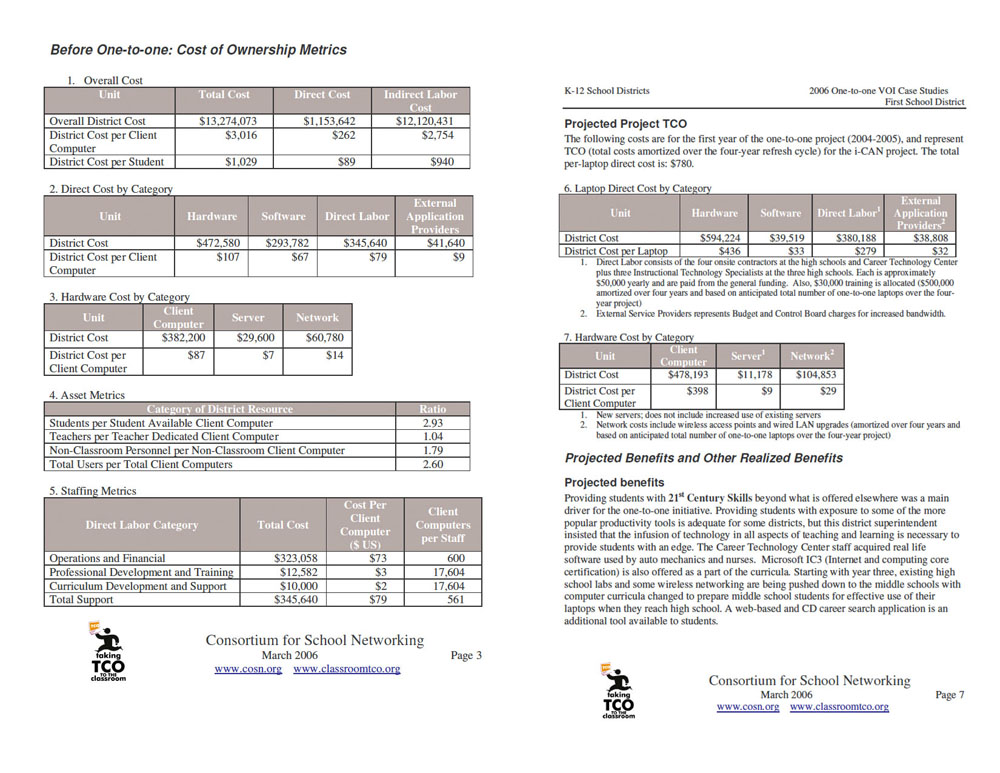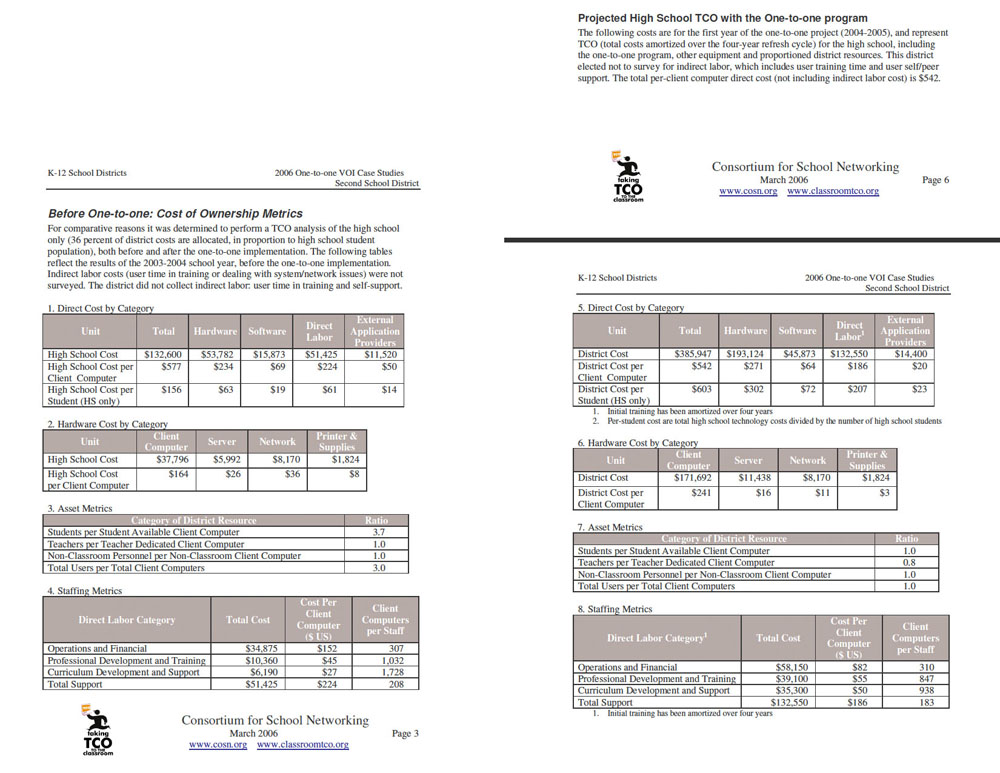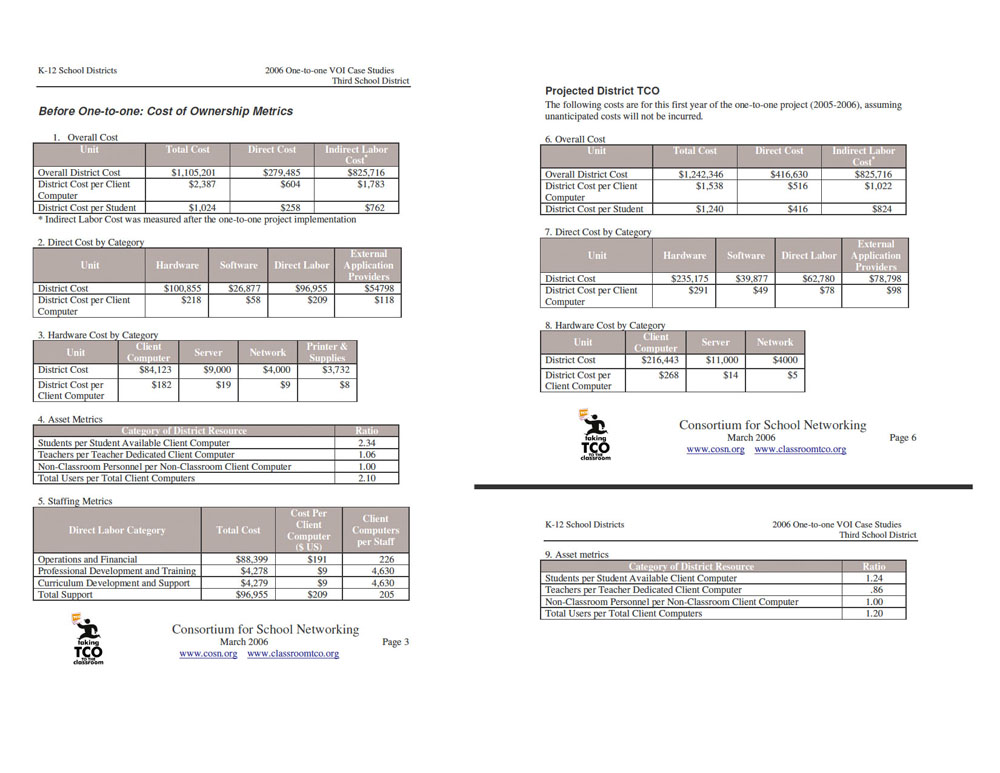Course:ETEC522/2010ST1/OneToOneTechnologies/TCO
Go back to One-to-One Home Page
Module 7: One to One Technologies - Total Cost of Ownership (TCO)
Total cost of ownership (TCO) is a financial estimate for owning networked computers. There are three major cost categories to consider: technology, direct labour, and indirect labour. The Consortium of School Networking (CoSN) also points out 7 major expenses and technology decisions school administrators must consider: device, support, professional development, connectivity, software, replacement, and retrofitting.
Overview of TCO
Values of TCO
The Consortium of School Networking (CoSN) lists the following as reasons why schools should conduct TCO:
- Understand the true overall spending on technology.
- Manage and assess technology investments, and initiatives in the context of organizational goals.
- Assist in developing budgetary guidelines.
- Identify and document spending for individual technology services.
- Inform stakeholders of the solid analytical management practices being followed when making funding requests.
CoSn says, “A district’s technology budget is no different from its transportation budget. When a school district buys a new bus, the expense doesn’t stop with the cost of the vehicle. There is gasoline to keep it running, maintenance to keep it well tuned, repair bills when it breaks down, increases in insurance premiums and the salary of an additional driver – expenses that all must be covered year after year.” (Consortium for School Networking, 2001, p. 3).
Breakdown of TCO
There are three major categories when one considers TCO: technology, direct labour, and indirect labour.
- Technology includes computers, servers, software, printers, networking equipment, and external application service providers.
- Direct labour can be calculated as the burdened labour cost of all internal and outsourced personnel whose formal job assignment includes support for technology.
- Indirect labour is the nonbudgeted support costs incurred outside the formal or visible technology support structure. It reflects the time that computer users spend in training or dealing with their own or others’ computer system or network issues. In other words, indirect labour is overhead time required by users to obtain the value of computer applications and networks (Kaestner, 2008).
According to the data from the case studies conducted by CoSN, an average total cost of ownership is broken down into 23% for technology, 21% for direct labour, and 56% for indirect labour. “This indirect labour time spent by users translates to somewhere between 10.5 and 13.7 hours per month per teacher and nonteaching staff member” (Kaestner, 2008, p. 22). In the same case studies, per-client-computer averages in price were: $392 for technology, $354 for direct labor, and $959 for indirect labor (total of $1705) (Kaestner, 2010).
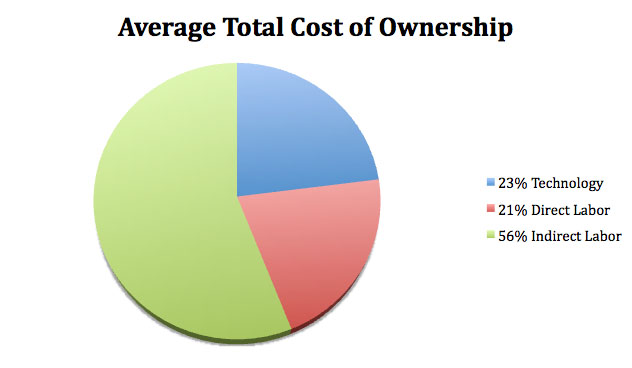
Technology Budget
The Consortium of School Networking (CoSN) lists the following as major expenses and technology decisions school administrators must consider after the purchase of computers and installment to a networking infrastructure.
- Support: the cost of supporting personnel to maintain the hardware and network and solve hardware and software problems.
- Schools typically have low levels of support, usually one person for every 500 computer users (Consortium for School Networking, 2001, p. 16).
- Professional Development: the cost to train teachers and staff members how to integrate technology into their curriculum.
- The US Department of Education recommended in 1996 that school district set aside 30 percent of their technology budgets for staff training and development (Consortium for School Networking, 2001, p. 13).
- The Mckinsey study assumed that a district planning to network all of its classrooms would have to hire substitute teachers at a cost of $100 a day, as well as the equivalent of 1.5 full-time stuff members to conduct training, and cover the cost of training materials (Consortium for School Networking, 2001, p. 14).
- Connectivity: the cost of connecting to the Internet.
- Software: the cost to purchase software or license fees
- Replacement: the cost to replace hardware
- School districts should be prepared to replace a computer every five years (Consortium for School Networking, 2001, p. 21).
- Retrofitting: the cost to wire an existing physical location.
- The average school would spend $240,000 on electrical upgrades and $31,800 on their heating, ventilation and air conditioning systems (Consortium for School Networking, 2001, p. 12)
One to One Laptops - Total Cost of Ownership
Overview
According to Rockman (2004), "One in every six U.S. districts has some form of one-to-one computer learning program in one or more of its schools." Calculating the Total Cost of Ownership is key to a successful and effective implementatin of one to one laptop program. The TCO should include major expenses mentioned in the previous section [refer to 1.3 Technology Budget]. The Centre for Digital Education estimated in 2004 that total costs for one-to-one initiatives range from $1,000 to $1,600 per student, including the hardware, software, staff development and IT support.
Here are some examples of TCO in one to one laptop programs:
- $1,200 per machine for approximately 1,200 students and 200 staff members for a leasing program (Watertown High School in South Dakota).
- $450 per laptop per year (Cobb County, GA)
- $300 per student per year (Henrico County Public Schools in Virginia)
- Most schools charge families an annual insurance fee of $25 to $75 to cover loss and damage (Center for Digital Education, 2004).
- Operating budget(s) and reallocations
- Student Fees
- Incentives
- Grants
- State/Federal Legislative appropriations
- Local option taxes or levies
- Local business or other private funding (Center for Digital Education, 2005)
Funding
There are various ways school districts nationwide have funded one-to-one initiatives. The Centre for Digital Education lists the following as funding strategy suggestions:
Case Studies
Here are TCO from three case studies conducted by the Consortium for School Networking.
District One Case Study
This rural/small town district with 10,200 students in South Carolina is in the second year of its one-to-one program. The approach is to provide laptops to all freshmen at each of three high schools plus a career/technology center. Freshmen will keep their laptops through four years of high school. Each year additional laptop computers will be leased for that year’s freshman class till the fourth year when all high school students will have a laptop. A baseline TCO assessment, prior to the laptop program, was performed for the district and a one-to-one project TCO was calculated. The one-to-one TCO included only project numbers: that is, just laptop computers and project related technology and labour costs, providing total and per-computer costs for the oneto- one project (Consortium for School Networking, 2006).
(Data retrieved from http://classroomtco.cosn.org/one_to_one_case_studies/District1CaseStudy.pdf)
District Two Case Study
This mostly rural 1,800 student district is located between two metropolitan areas in Pennsylvania and is in the second year of its one-to-one student laptop program. It has provided laptops to all students in the high school. The laptops were leased to spread initial costs over the useful life of the equipment. A baseline TCO assessment for the high school only for the year prior to the laptop program was performed, followed by a TCO assessment for the high school reflecting year one of the one-to-one project, showing overall high school total, per-client computer and per-student TCO both before and after implementation (Consortium for School Networking, 2006).
(Data retrieved from http://classroomtco.cosn.org/one_to_one_case_studies/District2CaseStudy.pdf)
District Three Case Study
This small rural district in Pennsylvania has moved from an already technology-rich environment to one-to-one laptops for seventh through twelfth grades. The laptop program is being funded largely through a three-year grant and the laptops are being leased accordingly. A baseline TCO assessment for the district (K-12) for the year prior to the laptop program was performed, followed by another district-wide TCO assessment reflecting the one-to-one student laptop program. Total district and per client computer and per-student TCO numbers are presented (Consortium for School Networking, 2006).
(Data retrieved from http://classroomtco.cosn.org/one_to_one_case_studies/District3CaseStudy.pdf)
TCO Tools
There are several online TCO tools. Here is one example of TCO calculator [sign up required.]
Report Card
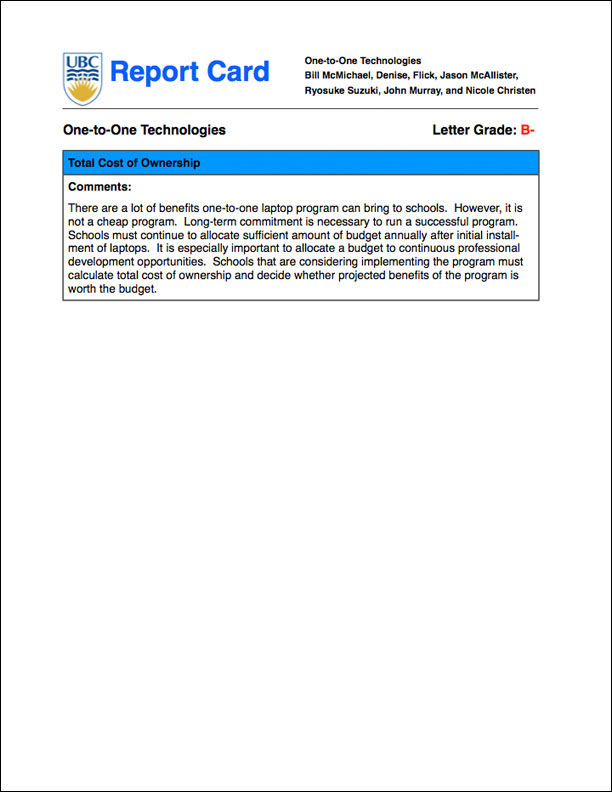
Move on to TeacherReluctance
Go back to One-to-One Home Page
References
Bouterse, B., Corn, J., & Halstead, E. (2009). Choosing the Perfect Tools for One-to-One. Learning & Leading with Technology, 32 (1), 14-17.
Center for Digital Education. (2005). K-12 One-To-One Computing Handbook. Retrieved from http://www.convergemag.com/paper/K-12-One-To-One-Computing-Handbook.html
Center for Digital Education. (2004). One-to-One Laptop Initiatives. Retrieved from http://i.bnet.com/whitepapers/K12WhitePaperHiResFinal05.pdf
Consortium for School Networking. (2001). A School Administrator's Guide to Planning for the Total Cost of New Technology. Retrieved from http://www.cosn.org/Initiatives/ClassroomTotalCostofOwnership/CoSNResources/tabid/5120/Default.aspx
Consortium for School Networking. (2006). A Report and Estimating Tool for K-12 School Districts One-to one Student Computing, Total Cost of Ownership, Value of Investment, District 1 TCO/VOI Case Study. Retrieved from http://classroomtco.cosn.org/one_to_one_case_studies/District1CaseStudy.pdf
Consortium for School Networking. (2006). A Report and Estimating Tool for K-12 School Districts One-to one Student Computing, Total Cost of Ownership, Value of Investment, District 2 TCO/VOI Case Study. Retrieved from http://classroomtco.cosn.org/one_to_one_case_studies/District2CaseStudy.pdf
Consortium for School Networking. (2006). A Report and Estimating Tool for K-12 School Districts One-to one Student Computing, Total Cost of Ownership, Value of Investment, District 3 TCO/VOI Case Study. Retrieved from http://classroomtco.cosn.org/one_to_one_case_studies/District3CaseStudy.pdf
Consortium for School Networking. (2006). One to One Case Studies Overview. Retrieved from http://classroomtco.cosn.org/one_to_one_case_studies/One2OneOverview.pdf
Kaestner, R. (2008). A Holistic View of the Total Cost of Technology. School Business Affairs, November 2008, pp. 21-22.
Kaestner, R. (2010). The Cost of Technology Total Cost of Ownership [PowerPoint slides]. Retrieved from http://www.cosn.org/Default.aspx?grm2catid=59&tabid=5120
